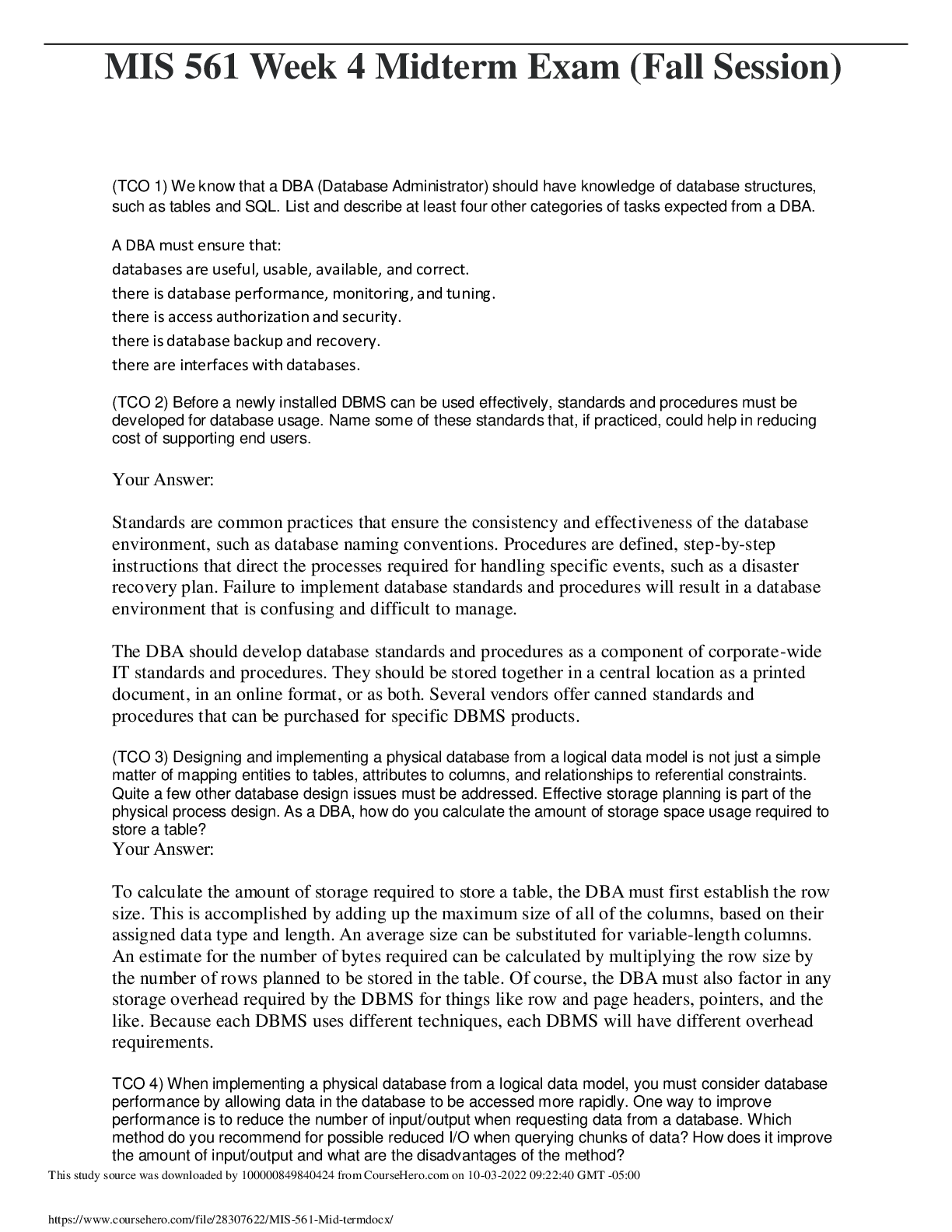NR 511 Week 4 Midterm Exam Answers,100% CORRECT
Document Content and Description Below
1. Define diagnostic reasoning 2. What is subjective data? 3. What is objective data? 4. Identify components of HPI 5. Describe thhe differences between medical billing & medical coding. ... 6. Compare & contrast thhe two coding classification systems that are currently used in thhe US healthcare system. 7. How do specificity, sensitivity, & predictive value contribute to thhe usefulness of diagnostic data? 8. Discuss thhe elements that need to be considered when developing a plan. 9. Describe thhe components of medical decision making in E&M coding. 10. Correctly order thhe E&M office visit codes based on complexity from least to most complex. 11. Thhe 5 key components of a comprehensive treatment plan are: 12. Define thhe components of a SOAP note. 13. Discuss minimum of three purposes of thhe written history & physical in relation to thhe importance of documentation. 14. Why does every procedure code need a corresponding diagnosis code? 15. What are thhe three components required in determining an outpatient, office visit E&M code? 16. Correctly ID a pt as a new or established given historical info. P 17. What does a well-rounded clinical experience mean? 18. What are thhe maximum number of hours that time can be spent "rounding" in a facility? 19. What are 9 things that must be documented when inputting data into clinical encounter logs? 20. What does thhe acronym SNAPPS st& for? 21. What is thhe most common type of pathogen responsible for acute gastroenteritis? 22. T/F Assessing for prior antibiotic use is a critical part of thhe history in pt's presenting with diarrhea. 23. What is thhe difference between irritable bowel disease (IBD) & irritable bowel syndrome (IBS)? 24. What are two common IBD's? 25. Describe thhe characteristics of acute diverticulitis. 26. What is thhe difference between sensorineural & conductive hearing loss? 27. What is thhe triad of symptoms associated with Meniere's disease? 28. What symptoms are associated with peritonsilar abscess? 29. What is thhe most common cause of viral pharyngitis? 30. What is thhe most common cause of acute n/v? 31. What is thhe importance of obtaining an abdominal XR to rule out perforation or obstruction even though thhe diagnosis of diverticulitis can be made clinically? 32. What are colon cancer screening recommendations relative to certain populations? 33. Identify at least two disorders that are considered to be disorders related to conductive hearing loss. 34. What is thhe most common cause of bacterial pharyngitis? 35. What are thhe clinical findings associated with mononucleosis? 36. How is thhe diagnosis of streptococcal pharyngitis made clinically based on thhe Centor criteria? 37. What is one intervention for a pt with gastroenteritis? 38. When are stool studies warranted? 39. What is an appropriate treatment for prophylaxis or treatment of traveler's diarrhea? 40. Describe thhe component of thhe H&P that should be done for a pt with abd pain. 41. What is at least one effective treatment for IBS? 42. What is at least one prescription med used to treat chronic constipation? 43. What is at least one treatment for Meniere's disease? 44. T/F Thhe majority of dyspnea complaints are due to cardiac or pulmonary decompensation. 45. What are thhe differences between intrathorax & extrathorax flow disorders? 46. What are at least 3 examples of flow & volume disorders (intra &/or extra thorax)? 47. Differentiate between rubeola, rubella, varicella, roseola, 5ths disease, pityriasis rosea, h&/foot/mouth, & molluscum contagiosum. 48. What are common characteristics in a rash caused by Group A strep? 49. What are treatment options for Group A B-hemolytic strep pharyngitis? 50. Differentiate between tinea pedis, cruris, corporis, & unguium. What are thhe appropriate treatments for each? 51. What is thhe virus that causes warts? 52. Differentiate between atopic & contact dermatitis. Give examples of each. 53. What is a normal response to TB skin tests & what does it mean? 54. What are some common reasons for decreased responsiveness to TB skin testing? 55. What are some common meds used to treat TB? 56. What is thhe MOA & common SE's of Isoniazid? 57. What is thhe MOA & common SE's of Pyrazinamide? 58. What is thhe MOA & common SE's of Ethambutol? 59. What are thhe different strengths of tretinoin & when is each appropriate? 60. Identify various types of lesions based on thheir characteristics: Rubeola: Pt looks ill High fever Red mucus membranes Conjunctivitis Nasal congestion Reddish/purple generalized macular/papular rash Lesions start on head (face/behind ears), spread over rest of body in 1-2 days Rubella: Low-grade fever HA Sore throat Rhinorrhea Malaise Eye pain Myalgia 2-5 days before rash Rose-pink macules/papules Lesions start on head, travel down body Rash disappears in 1-2 days in same order it appeared Varicella: Malaise Fever Chills HA Arthralgia 1-2 days later, urticarial erythhematous macules/papules appear, quickly turning to vesicles/pustules Rash starts on face/chest, spreads quickly over entire body, dry up in 1 week Roseola: High fever Irritability Diarrhea Cough Cervical lymphadenopathy Light pink erythhematous macules/papules on face, neck, extremities, resolves in 1-3 days Fifth's Disease: Starts with HA, fever, chills, maybe cough Stage 1: "Slapped cheek" rash Stage 2: Pink lacy erythhematous macules on extremities/trunk, spares palms & soles. May be itchy. Stage 3: 2-3 weeks of body rash Pytiriasis rosea: 2-4 patches or plaques on trunk that starts 2-3wks before general rash, aka "herald patch" Rash pink to erythhematous, round to oval plaques & papules with possibly scaly borders Rash resembles shape of Christmas tree Rash can be itchy Low-grade fever HA Fatigue Can last 1-2mo or longer H&, foot, & mouth: Mouth sores usually first to appear H& vesicles are erythhematous halos, mostly soles & palms Sometimes are on legs, butt, face Usually resolve in 7 days Molluscum contagiosum: Tiny pustules 2-5mm Flesh-colored dome, some have slightly depressed center Single or multiple lesions Kids: thighs & arms Adults: genital region from sexual contact Soles & palms always spared Sometimes erythhematous & scaly Can last 8mo or longer Folliculitis: Little pustules or erythhema around base of hair follicle Abscesses: Sac or pore filled with pus Erythhematous, tender nodule that can be fluctuant Furuncle: infection that involves hair follicle & extends into surrounding tissue Mostly on axillae, neck, buttock Carbuncle: Cluster of abscesses that connect subcutaneously to form mass Group A strep: Red s&paper rash Fever Bright red sore throat Lymphadenopathy Bright red skin in skin folds Tinea pedis: Erythhematous, scaly, possibly inflammation or itching on feet Tinea Cruris: Jock itch Rash present on inner thighs, butt, groin Well-demarcated erythhematous or tan plaques with raised scaly borders Tinea corporis: Ringworm On extremities or trunk Erythhematous annular lesion w/scaly macules/papules, well-defined edge May be itchy Edge is raised & center is inflamed Tinea unguium: Onychomycosis Fingernails or toenails Appearance varies: yellow, green, black, white ridging, cracking of nails Warts: HPV causes Skin colored rough papule, sometimes grayish surface Single lesions or clusters Sometimes tiny black or red dots in lesions Scabies: Intense itching worse at night Light pink curved or linear burrows, occasionally w/black dot on one end Commonly in between fingers & toes Aktinic keratosis: Result of cumulative sun exposure & aging Rough textured skin, maybe flesh or pink colored Sometimes thick & scaly, can evolve into plaque Sometimes stinging sensation when rub area Lesion never goes away, no matter how much moisturizer used Vitiligo: Michael Jackson disease Depigmented areas of skin Well-demarcated Macules or papules surrounded by normal skin Contact dermatitis: Allergic reaction to substance Pruritic & erythhemic rash Occurs on area that was directly exposed to reaction Atopic dermatitis: Patches of itchy, dry skin Can be red to brownish-gray May have small raised vesicles that leak when scratched 61. What are common characteristics associated with blepharitis, chalzion, & hordeolum. Blepharitis: irritation, burning, itching, scales, redness. If lice is cause: reddish brown crust in lashes (not white or clear as typically seen). Chalzion: mass in mid-portion of upper lid away from margin. Usually not painful or tender. Slightly red, swollen. Hordeolum: usually on outside of lid, abscess on lid margin. Redness, swelling, painful. 62. Differentiate between viral, allergic, bacterial, toxic, & HSV conjunctivitis. Bacterial: aka pink eye. Direct h&-to-eye contact w/infected person. Spread of one's own nasal/sinus bacteria during illness. Purulent discharge (HALLMARK) Reddened conjunctiva Eyelid swelling Can start unilat, but can spread bilat. May resolve without treatment, but abx drops can shorten duration. Very contagious (stay home until 24hrs of abx treatment or when clinical improvement noted). Viral: usually caused from adenovirus, but can be HSV, HZV, molluscum contagiosum. Irritation, mild light sensitivity, swollen lids, mild FB sensation. Mild conjunctival hyperemia to insense hyperemia. Watery/mucousy drainage, not purulent. Enlarged tender preauricular lymph nodes on affected side. Red throat, nasal drainage, ear infection, etc. Self-limiting, resolve on thheir own from few days to few weeks. Highly contagious Current recommendation is stay home until redness/tearing resolved. Allergic: usually caused by environmental allergen (pollen, grass, trees, etc.). Can be seasonal & can be isolated to eyes or include upper resp allergy symptoms such as rhinitis. Hallmark characteristic: itching Diffuse, milky, conjunctival hyperemia Swollen conjunctiva Tearing Almost always bilat Uniquely identifying bumps on conjunctiva ("follicles") Tx: symptomatic. Artificial tears, anti-allergy drops. Toxic: due to overuse of topical ocular meds (Visine), but abx drops most common (usually from using abx drops for longer than prescribed or for viral infections). Clear, watery discharge & red conjunctiva Dx usually from history Tx: stop thhe drops HSV: spread by contact w/persons who have visible, infected lesions & w/persons symptomatically shedding thhe virus. Pt may be experiencing prodrome of ill-related symptoms (malaise, low grade fever, pain/tingling near site of lesions but lesions not yet visible). Skin vesicles Conjunctivitis (same as viral) Corneal infection w/hallmark dendrite appearance 63. Which chemical injury is associated with thhe most damage & highest risk to vision loss? Moderate to severe alkali (ammonia, drain cleaners, cement, plaster/mortar, airbag rupture, fireworks; all contain ammonia, lye, lime, sodium, mag hydroxide). 64. Which cardiac or pulmonary disorders contribute to thhe majority of dyspnea complaints due to decompensation? asthma; chronic obstructive lung disease; malignancy; heart failure; interstitial lung disease; pneumonia; valvular heart disease; intracardiac shunt; arrhythmias; cardiomyopathies; myocardial ischemia. 65. What are appropriate tests in thhe work-up for dyspnea? CXR to rule out tumors, TB, PNA, othher major pulmonary disorders. CBC w/diff to rule out anemia, infection Peak expiratory flow test (in office) to determine degree of expiratory airflow obstruction in pt's with asthma, COPD EKG Echo Spirometry to determine obstructive, restrictive, mixed lung dz Sleep apnea or sleep hypoxia testing 66. Describe classes of asthma. Mild intermittent: Less than once weekly Brief exacerbations lasting few hrs to few days Nighttime symptoms <2/wk PEFR or FEV1: >80% predicted PFT variability >20% Mild persistent: Symptoms >2/wk but <daily. May be several times at night/month May effect sleep PEFR or FEV1 >80% PFT variability 20-30% Moderate persistent: Daily but not continual Nighttime, but not every night More than once weekly Exacerbations affect activity/sleep Daily use of short-acting beta-2 agonist PEFR or FEV1 60-80% PFT variability >30% Severe persistent: Continuous daily Frequent nighttime Frequent exacerbations Physical activity limited PEFR or FEV1 < or = 60% PFT variability >30% 67. What are thhe different treatments for thhe asthma classes? Mild intermittent: No daily meds PRN inhaled short acting beta-2 agonist or cromolyn before exercise or allergen exposure Mild persistent: One daily controller med (inhaled corticosteroid), cromolyn/nedocromil, leukotriene modifiers Inhaled beta-2 agonist PRN Moderate persistent: Daily meds: combo inhaled medium dose corticosteroid & long-acting bronchodilator: cromolyn-nedocromil, leukotriene modifiers Severe persistent: Inhaled beta-2 agonist PRN Multiple daily controller meds: high dose inhaled corticosteroid, long-acting bronchodilator, cromolyn/nedocromil, leukotriene modifiers. 68. Identify respiratory characteristics of chronic bronchitis. Characterized by excessive mucus secretion in bronchial tree Manifests by chronic or recurrent cough (with or without sputum), present on most days for minimum of 3mo of thhe year for at least 2 consecutive years. Pts usually use accessory muscles with respiration & have dyspnea with or whitout sheezing. Pts may have s/s of right HF (edema, cyanosis). FVC: normal to increased RV: increased TLC: normal EFR: normal to decreased FEV1/FVC: decreased 69. Identify respiratory characteristics of asthma. Chronic, inflammatory, obstructive disease in airways. May occur at any age & presents with wheezing (airway spasms), chest tightness, dyspnea, cough. Reversible hyperreactivity of bronchi & bronchioles to a variety of stimuli. FVC: normal RV: normal, increased during attacks TLC: normal to increased EFR: normal to decreased FEV1/FVC: normal to decreased 70. Identify respiratory characteristics of COPD. Progressive disease characterized by presence of airflow obstruction due to chronic bronchitis or emphysema. 3rd leading COD in US. Dz of lung parenchyma & small airways Pts may be asymptomatic for 10-20yrs except for frequent colds, persistent morning cough, URIs. Pts present with fatigue, SOB, cough, hyperinflation (barrel chest), wheezing, decreased breath sounds, hyperresonance. Stage 1 (mild): FEV >80%. Stage 2 (moderate): FEV 50-79% Stage 3 (severe): FEV 30-49% Stage 4 (very severe): FEV <30% 71. What is thhe CURB-65 tool & how is it used? Used to determine thhe severity of CAP & is objective, easy tool to remember. C: confusion U: BUN >19 R: resp rate >30 B: BP syst <90 or diast <60 65: >65yo 1 point awarded for each. 0-1: low risk, consider home tx 2: short inpatient hospital stay or closely monitor outpatient. 3 or more: severe pna, hospitalize & consider ICU 72. What are subjective & objective findings with asthma? Subjective: SOB CP/tightness Objective: Wheezing Dyspnea Excessory muscle use Peak flow meter readings varied Non-productive cough 73. What are subjective & objective findings with COPD? Subjective: SOB Chest tightness Urge to clear lungs in morning Fatigue Objective: Wheezing Cough w/sputum chronically & consecutively Cyanosis URIs diagnosed Wt loss Edema 74. What are subjective & objective findings with sinusitis? Subjective: HA Pain in sinuses Facial tenderness Sore throat Cough Persistent symptoms lasting >7days Objective: Fever, Discolored nasal drainage Facial swelling Bad breath 75. What are subjective & objective findings with allergic rhinitis? Subjective: itchy throat/nose/eyes Watery eyes Head/nasal congestion Fatigue Ear pressure Sneezing Objective: Cobblestoning in back of throat Post-nasal clear drip Red eyes 76. What are subjective & objective findings with vasomotor rhinitis? Subjective: Stuffy nose Congestion Sneezing Cough non-productive Objective: Clear post-nasal drip Possible cobblestoning 77. What are subjective & objective findings with influenza? Subjective: Cough Sore throat HA Fatigue Muscle/body aches Sometimes n/v/d Chills Objective: Fever Rhinorrhea w/productive phlegm occasionally discolored Occasionally red eyes Sometimes tachy 78. What are treatment options for asthma? Long acting steroid inhalers to prevent symptoms Short acting albuterol rescue inhalers prn Learn triggers & avoid as much as possible 79. What are treatment options for COPD? Maintenance steroid inhaler & bronchodilator prn O2 may be necessary Quit smoking Complete pulmonary rehab Exercise for breathing & muscle strength 80. What are treatment options for sinusitis? Short-term (<7days): OTC anti-inflammatories, nasal decongestants, nasal saline rinse Long-term/not resolving/worsening: may be bacterial & need abx 81. What are treatment options for allergic rhinitis? Antihistamines OTC anti-inflammatory prn Decongestant prn ID & avoid allergens & causative factors Avoid touching face or eyes as much as possible 82. What are treatment options for vasomotor rhinitis? Similar to allergic rhinitis 83. What are treatment options for influenza? Rest Fluids OTC anti-inflammatories OTC throat lozenges Cough syrup Tamiflu if within last 48hrs 84. Define & describe chronic cough. Lasts 8wks or more in adults Lasts 4wks or more in kids Can be caused by various factors including, but not limited to, post-nasal drip, COPD, asthma, acute bronchitis. Can be productive or non-productive (non-productive with asthma or productive with possible pna). 85. What are common eye emergency conditions that require emergency room eval? Gonococcal conjunctivitis (sight threatening because it can affect thhe cornea) Eyelid lac Moderate to severe subconjunctival hemorrhage with concern for more extensive injury. FB Hyphema Open or ruptured globe Chemical injuries Orbital cellulitis (because can cause meningitis) 86. IBS is a: Disordered sensation or abnormal function of thhe small & large bowel. Can lead to abd pain & alteration in bowel habits. 87. Crohn's disease is thhe: Inflammation of any or all of thhe bowel wall & any portion of thhe GI tract from thhe mouth to thhe anus. Can result in "skipped lesions." 88. Ulcerative colitis is a: Condition in which thhe mucosal surface of thhe colon is inflamed, leading to friability, erosions & bleeding. Can affect thhe entire colon. 89. T/F If you suspect diverticulitis, you can treat with abx alone. No imaging is necessary. False 90. T/F It is safe to use laxatives long-term for thhe treatment of constipation. True (practice quiz was wrong, per instructor feedback & lesson) 91. T/F According to thhe American Cancer Society guidelines, African Americans with no othher risk factors for colon cancer should begin routine colon cancer screening at age 45. True 92. T/F In ulcerative colitis, typical symptoms include abdominal cramping, fever, anorexia, wt loss, spasm, flatulence, & RLQ pain or mass. Stools may contain blood, mucous, &/or pus. False 93. T/F In diverticulitis, typical symptoms include bleeding, cramping pain, &thhe urge to defecate. Stools are characteristically watery diarrhea with blood & mucus. False 94. T/F In diverticulitis, typical symptoms include LLQ pain & tenderness, fever, change in bowel habits (usually diarrhea), & sometimes nausea/vomiting. True 95. Treatment of IBS with constipation: High fiber diet, Amitiza, Linzess. 96. Treatment of IBS with diarrhea: Lomotil, Imodium 97. Treatment of IBS with abd pain: Bentyl, tricyclic antidepressants 98. T/F Acute gastroenteritis is thhe most common cause of nausea & vomiting. True 99. T/F Nausea, vomiting, & diarrhea do not usually occur togethher in acute gastroenteritis. False 100. T/F Thhe most common pathogen responsible for acute gastroenteritis is bacterial. False 101. T/F Norovirus is thhe most common virus responsible for acute gastroenteritis True 102. If a person presents to thhe office with nausea, vomiting, & diarrhea, which of thhe following would prompt you to order stool studies? Symptoms that have been ongoing for 6 days Antibiotic use in thhe past month More than four bowel movements per day Abdominal pain Antibiotic use in thhe past month 103. Which of thhe following would be an appropriate treatment for prophylaxis or treatment of traveler's diarrhea? Amoxicillin Keflex Ciprofloxin Flagyl Ciprofloxin 104. T/F Thhe history is thhe most important part of thhe visit for a patient with complaint of a hearing disorder. True 105. T/F Meniere's disease is diagnoses of exclusion. True 106. T/F Thhe majority of TM ruptures will heal thhemselves. True 107. Age-related hearing loss (presbycusis) is classified as which type of hearing loss? Sensorineural 108. Thhe triad of symptoms associated with Meniere's disease include _____. Hearing loss, tinnitus, vertigo 109. Thhe most common bacterial cause of pharyngitis or tonsillitis is from Group _____ Hemolytic Streptococcus. A 110. Which are not findings associated with mononucleosis? Exudative tonsillitis Palatal petechiae & exantham Splenic enlargement Cough Cough 111. Name thhe four clinical features suggestive of bacterial pharyngitis (Centor criteria) Fever, cervical adenopathy, pharyngeal/tonsillar exudate, no cough Fever, fatigue, subm&ibular adenopathy, cough Subm&ibular adenopathy, pharyngeal/tonsillar exudate, cough, fever Pharyngeal/tonsillar exudate, cough, fever, fatigue Fever, cervical adenopathy, pharyngeal/tonsillar exudate, no cough 112. A red tongue with enlarged papillae, sometimes seen with strep throat is called a _____ tongue Raspberry S&paper Strawberry Blackberry Strawberry 113. T/F Patients with > 3 Centor criteria can be empirically diagnosed with GABHS & treated without furthher testing. True 114. T/F Empiric treatment of asymptomatic household contacts o patients with acute GABHS pharyngitis is recommended. False 115. T/F Doxycycline is an alternative for patients with GABHS pharyngitis who are allergic to PCN. False 116. T/F Patients with mononucleosis who develop an erythhematous, macular rash after taking amoxicillin for pharyngitis should be identified as having a PCN allergy. False 117. Which is (are) a symptom(s) of peritonsillar abscess? (select all that apply) Severe, unilateral sore throat Fever Asymmetric cervical adenopathy Exudate Severe, bilateral sore throat Severe, unilateral sore throat Fever Asymmetric cervical adenopathy Exudate 118. Thhe most common cause of viral laryngitis is _____. H. influenza 119. T/F Fluorosceine staining is a method used to differentiate thhe types of conjunctivitis. False 120. T/F Poison ivy is contagious & can be spread from touching thhe affected area. False 121. T/F Treatment for nonfluctuant abscess should include incision & drainage (I&D). False 122. Which is NOT treatment for warts? Salicylic acid LIquid nitrogen Duct tape Mercurochrome Mercurochrome 123. Tinea corporis is found on thhe: Trunk/extremities 124. Tinea unguium is found on thhe: nail 125. Tinea cruris is found on thhe: Groin 126. Tinea pedis is found on thhe: feet 127. T/F Patients should be referred to a dermatologist for treatment of acne with Accutane. True 128. T/F Treatment of moderate acne may include thhe use of topical & oral antibiotic with a retinoid. True 129. How is an appropriate differential developed? List of possible diagnoses in order of priority. Consider "skin in:" after complaint is given, clinician begins to consider all possible causes beginning with skin level & visualizing all structures in that area inward. 130. Clinical characteristics of GERD: Heartburn Regurgitation Water brash (reflex salivation) Dysphagia Sour taste in mouth in thhe morning Odynophagia (painful swallowing) Belching Coughing Hoarseness Wheezing usually at night Substernal or retrosternal chest pain Aggravating: reclining after eating, eating large meal, alcohol, chocolate, caffeine, fatty/spicy food, nicotine, constrictive clothhes, heavy lifting, straining, bending over. Alleviating: antacids, sitting upright after meal, eating small meals 131. Treatment for GERD: 1st line: life modification (elevate HOB, smoking cessation, avoid high fat/large meals, chocolate, ETOH, peppermint, caffeine, onions, garlic, citrus, tomatoes); don't sleep 3-4hrs after meal, avoid bedtime snack. Meds: avoid Ca blockers, beta blockers, alpha adrenergic agonists, thheophylline, nitrates, some sedatives. Encourage wt loss for overweight/obese pts If lifestyle mods not working: step-up/down treatment guidelines for GERD. Mild, intermittent symptoms: trial for 4wks, if symptoms persist, step up: 1. Dietary/lifestyle mods 2. Antacid 3. OTC H2-RA: cimetidine (Tagamet), ranitidine (Zantac), famotidine (Pepcid), nizatidine (Axid) Trial above for 6wks, if symptoms persist, step up +referral to GI: 1. Continue dietary/life mods 2. H2-RA Rx dosage: cimetidine 800mg TID, ranitidine 150mg TID, nizatidine 150mg TID, famotidine 20mg TID. OR PPI: omeprazole 20mg, rabeprazole 20mg, lansoprazole 30mg, esomeprazole 20mg, or pantoprazole 40mg daily. Trial above for 8wks, if symptoms persist step up: 1. Diet/lifestyle mods 2. PPI increase to 40mg daily Trial for 8wks, if symptoms persist, step up: 1. Diet/lifestyle mods 2. Surgical intervention 132. Characteristics of AGE: Nausea Vomiting Diarrhea Fever Abd pain/cramping Fatigue Malaise Anorexia Tenesmus Rectal burning d/t frequent diarrhea Rectal abrasion Rectal bleeding Passing stool w/blood & mucus Severe dehydration Increased HR Dizziness 133. Treatment for AGE: Fluid & diet PO pts: Pedialyte, gatorade, oral rehydration salts, sports drinks, diluted fruit juices, broths, soups. Boiled starches/cereals to facilitate enterocyte renewal Hosp pts: IV fluid Diarrhea: Pepto (can be used to treat acute diarrhea, but not as effective as loperamide; don't use w/abx in pts with HIV) Loperamide (Imodium): drug of choice for afebrile, nondysenteric cases of acute diarrhea Lomotil: Rx only, used in afebrile, nondysentery of acute diarrhea, has central opiate effects. Antibiotic treatments: Bacterial: C-diff (metronidazole/Flagyl 250mg x4 daily x10 days; vanc 125mg x4 daily x10 days). Vibrio cholerae (tetracycline 500mg PO q5hr x2 days; bactrim DS q12hr x2 days). Yersinia enterocolitica (tetracyclines 250-500mg q6hr x7-10days; cipro 500mg BID; tobramycin 3-5mg/kg q8h). Salmonella (Bactrim DS or quinoline, norfloxin 400mg or ofloxin 400mg x2 daily x7-10 days). Shigella (Bactrim DS BID x3 days) Viral: Rotavirus/norwalk virus: no treatment, treat symptoms 134. Eustachian tube disorder presentation, symptoms, causes: Presentation: depends on how it happened. Retracted TM, nasopharyngeal resemble allergic rhinitis, fusion may be present or not Symptoms: decreased hearing, muffled hearing, feeling of fullness in ear, inability to pop ear, disequilibrium, tinnitus, pain Causes: airplane, scuba diving, any disorder that can cause nasal congestion (allergic rhinitis, swollen adenoids, sinusitis, etc.) 135. Eustachian tube disorder treatment: Treat underlying problem Otitis media, sinusitis: treat w/abx Allergic rhinitis: nasal steroids, decongestants (not in kids <6 or HTN/CV disease) Chew gum, yawn DO NOT hold nose & blow! May pop TM. TM tubes placed sometimes to equalize pressure 136. Compare & contrast otitis media & otitis externa. Definition: OE: inflammation of membranous lining of auditory canal &/or contiguous structures of outer ear. OM: Inflammation of structures within middle ear Epidemiology/causes: OE: 10-20x more likely to occur during warmer/summer months than in cooler seasons. Adults >50 = greatest risk. No ethnic or gender predispositions. Immunocompromised people at greater risk (esp of invasive disease). Excess moisture from any cause increases risk. Seborrheic dermatitis, hearing aids, ear plugs, cotton swabs all increase risk with extended use. OM: Incidence increases in winter. Most common in very young or elderly. Native American (esp Navajo) & Native Alaskans = higher prevalence. Men & women = risk. More rare in adults. Risk factors: allergies, sinusitis, rhinitis, pharyngitis, recent/recurrent URI, perforation of eardrum, active/passive smoking. Pathogens: OE: Pseudomonas aeruginosa (most common cause of diffuse infection). Staph aureus. Group A strep pyogenes. Bacteroids. Peptostreptococcus. Aspergillus niger. Pityrosporum. C&ida albicans. OM: Strep pneumoniae (most frequent cause in adults). H influenzae. Moraxella catarrhalis. Strep aureus & strep pyogenes far less common causes. Clinical presentation: OE Subjective: acute, severe otalgia that may worsen at night. Worsens with pulling pinna or applying pressure to tragus. Chewing may exacerbate pain in severe cases. Initially ear may feel full/obstructed with temporary conductive hearing loss. May be pruritic. Systemic symptoms may be present with infectious etiology. Chronic illness may include dryness & pruritis of ear canal. OE Objective: tenderness on traction of pinna, pain w/pressure of tragus. Purulent drainage may be present w/bacterial infection. Canal may be reddened & edematous. Usually lacks cerumen. Auditory canal appears edematous/erythhematous. Diffuse cases may have localized pustules or furuncles in canal or external processes. Green exudate w/Pseudomonas. Yellow crusting in midst of purulent drainage w/Staph. Fungal infections have fluffy white/black malodorus carpet of growth. Allergic reactions are scaly, cracked, &/or weepy tissue. Usually no lymphadenopathy. TMJ tenderness may be present in invasive disease. OME Subjective: Stuffiness, fullness, loss of acuity unilaterally. Pain is rare. Popping, crackling, gurgling. Rarely causes vertigo. AOM Subjective: Deep ear pain. Fever. unilateral hearing loss. Recent URI. Dizziness. Vertigo. Tinnitus. Chronic repeated bouts of AOM. OME Objective: external ear usually unremarkable. Mucus membranes may be infected or edematous. TM may be dull but not bulging. AOM Objective: TM may be amber or yellow-orange. TM may be infected & pinkish gray to fiery red. TM typically full & bulging w/absent or obscured bony l&marks & cone light reflex. Discharge present if TM perf'd. Otorrhea may be purulent or mucoid. Chronic OM has perf'd, draining TM & possibly invasive granulation tissue. Lymphadenopathy or preauricular & post cervical nodes is common. If OM along with acute mastoiditis, tenderness over mastoid will be present. Management: OE: Localized application of heat or ice for pain. NonRx pain reliever for mild to mod pain. Tyl #3 for severe pain. Keep ear dry. Gentle cleaning of ear canal. Eval otic discharge & edema of auditory canal & TM. Select local med appropriate for etiology. May need I&D of pustules or furuncles. Diffuse infection may be treated empirically. Topical otic preps. Abx: 1st gen cephs or pcns, 2nd gen cephs, fluroquinolones, ceftazidime. OM: Uncomplicated is often self-limiting. Treatment recommended for chronic or recurrent OM. Supportive treatment indicated for acceptance of pt's auditory hearing loss r/t chronic dz. If symptoms persist >12wks, 10-day abx course is warranted. Abx: amox, augmentin, 2nd/3rd gen cephs. Steroids not recommended for kids. 137. What are thhe characteristics of nuclear cataracts? Significant nearsightedness Slow, indolent course 138. What are thhe characteristics of cortical cataracts? Does not significantly impair vision 139. What are thhe characteristics of posterior cataracts? Creates a subcapsular haze & a severe glare in bright light [Show More]
Last updated: 1 year ago
Preview 1 out of 48 pages
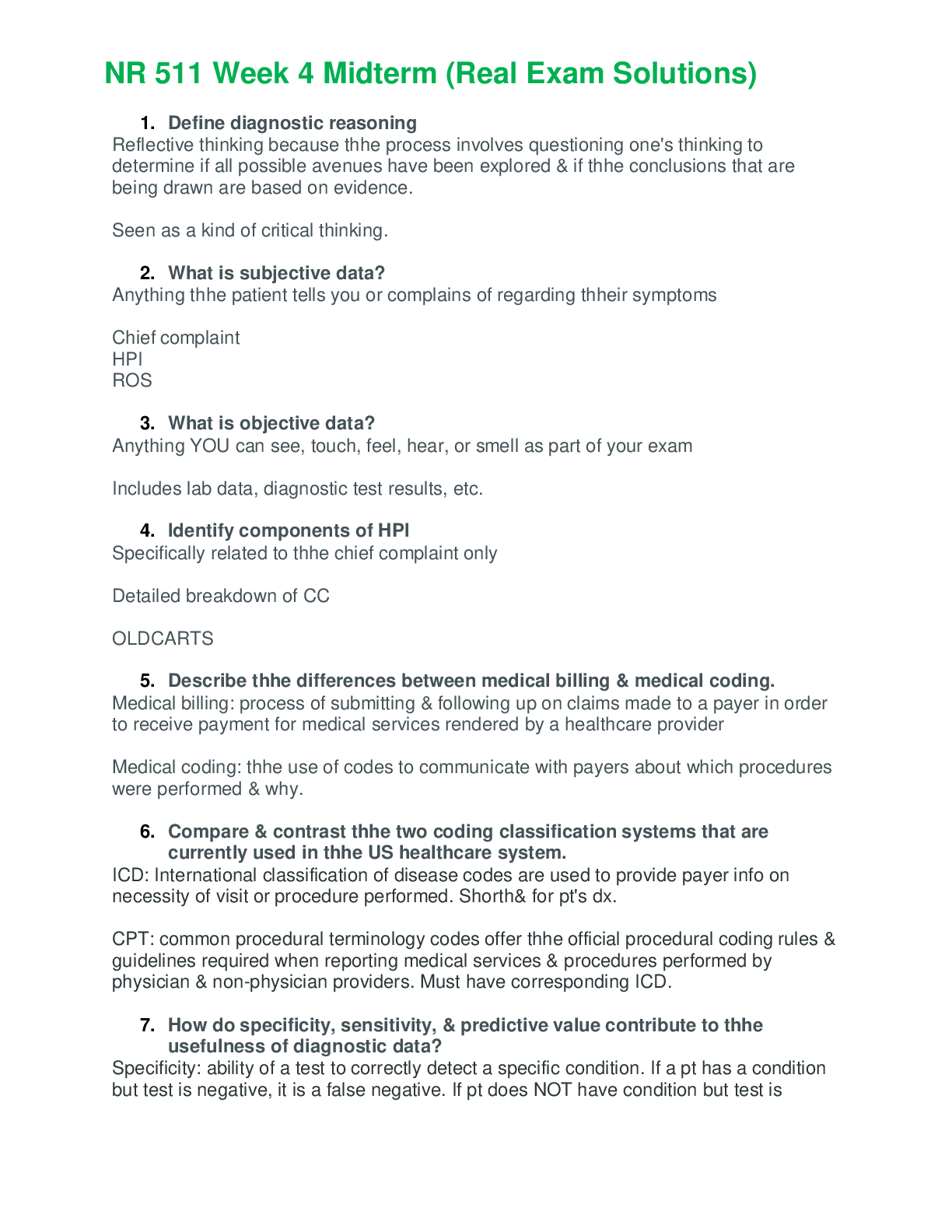
Reviews( 0 )
Document information
Connected school, study & course
About the document
Uploaded On
Jan 28, 2021
Number of pages
48
Written in
Additional information
This document has been written for:
Uploaded
Jan 28, 2021
Downloads
0
Views
34

















 – Chamberlain College of Nursing.png)
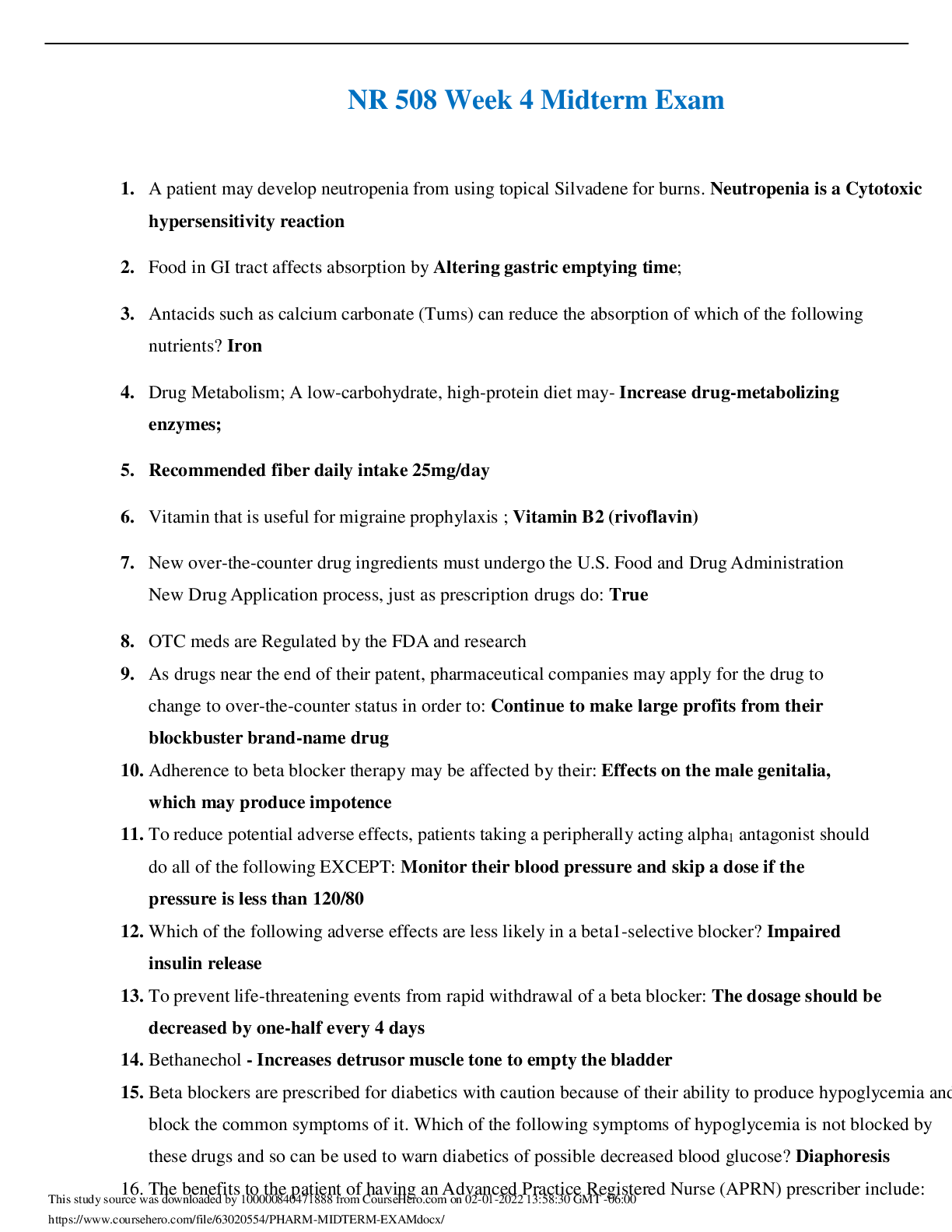




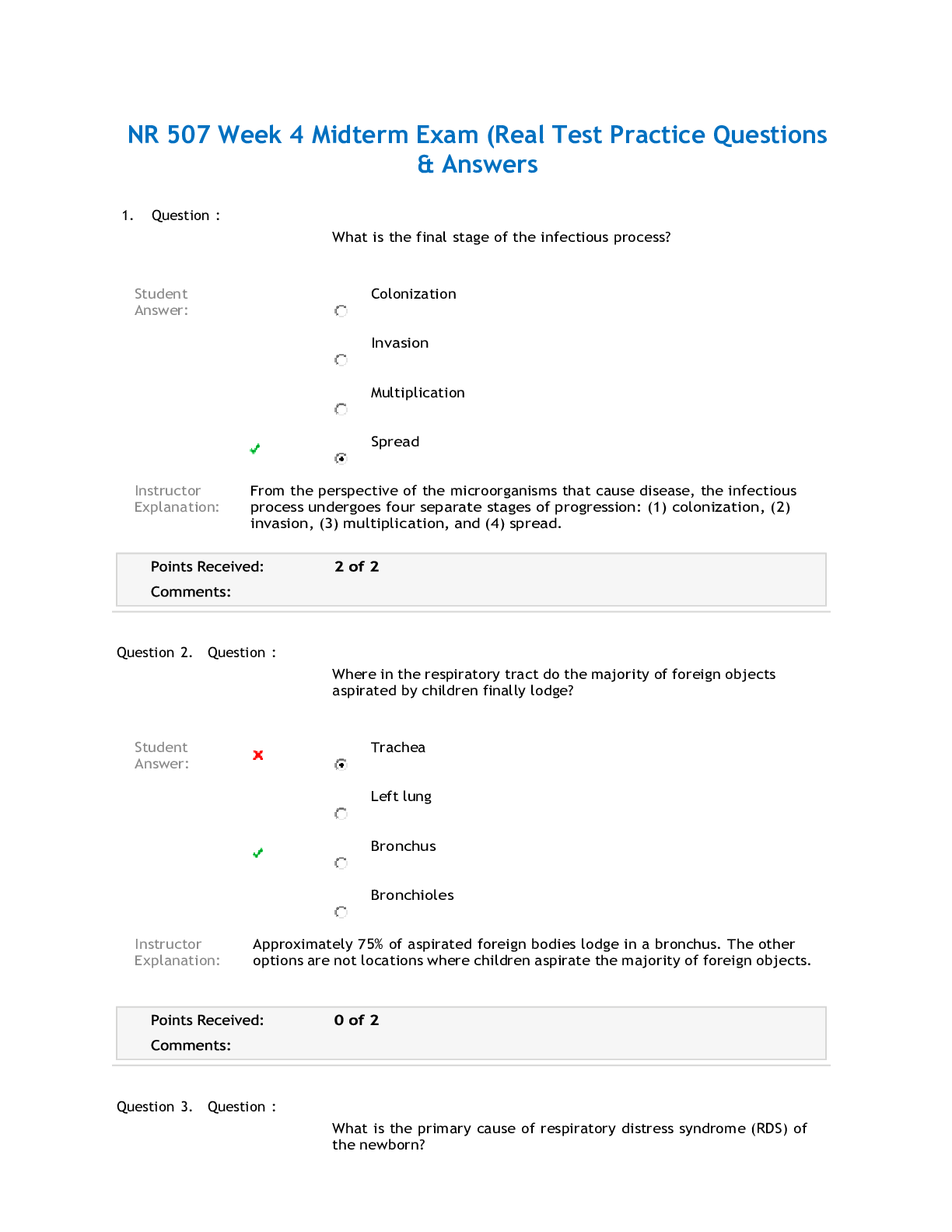

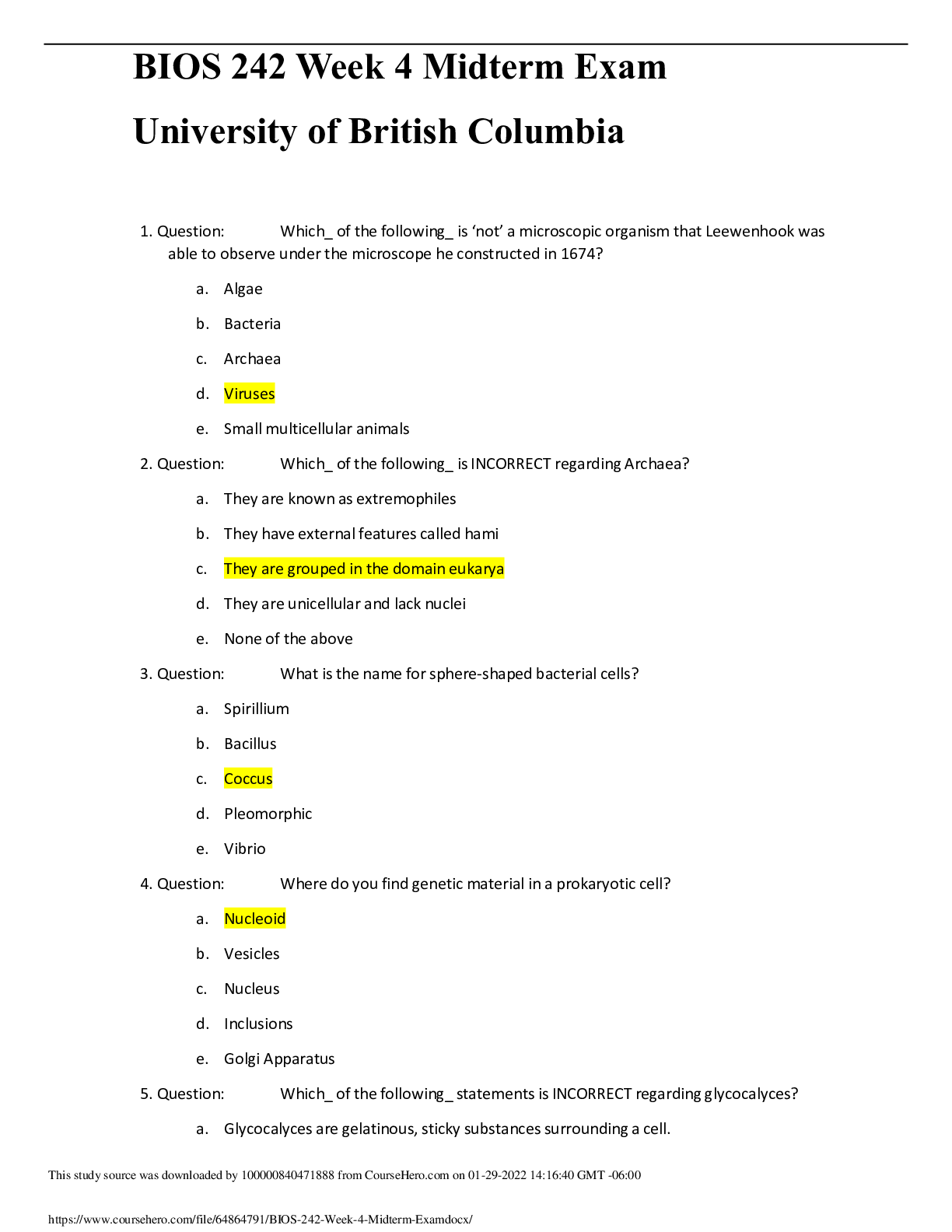
 – Chamberlain College of Nursing.png)
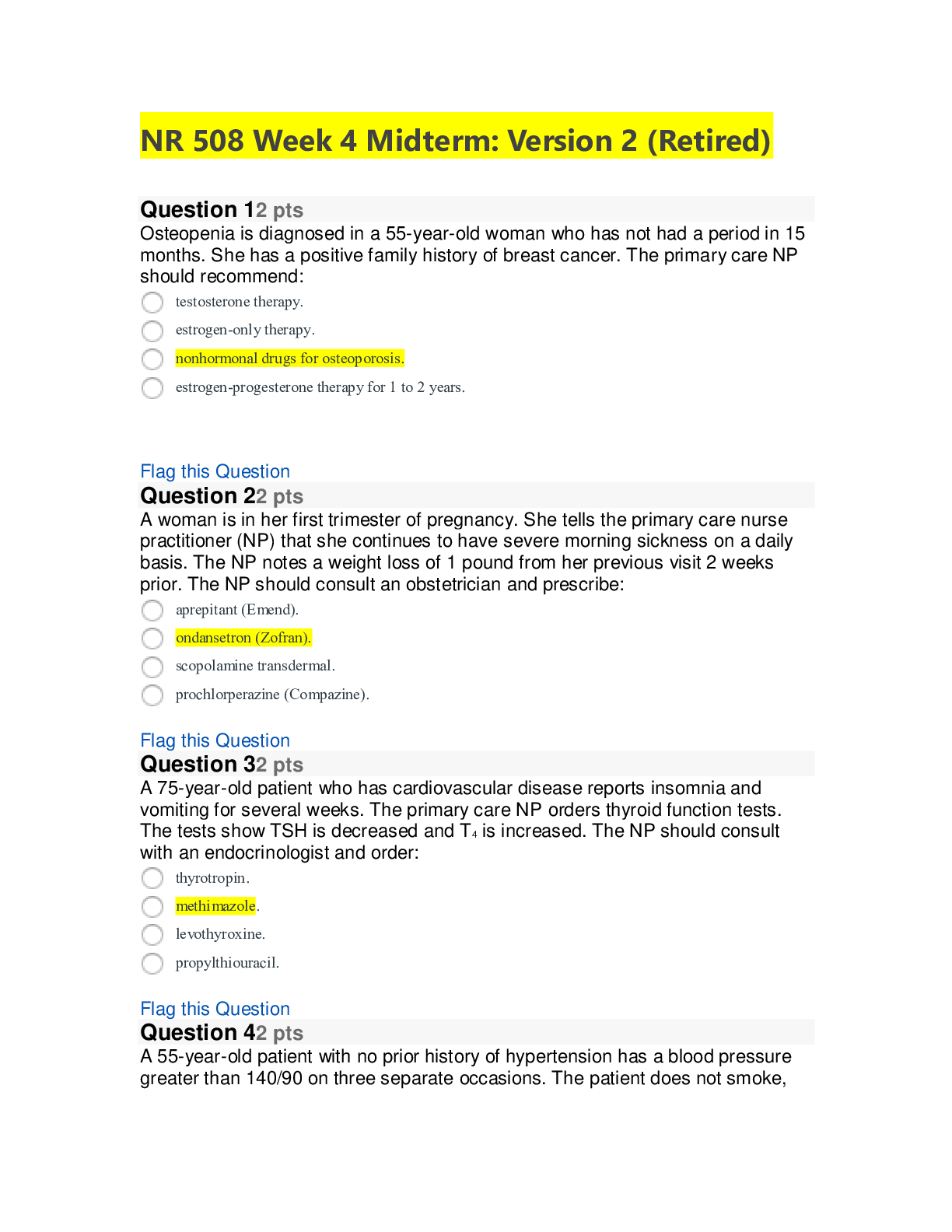




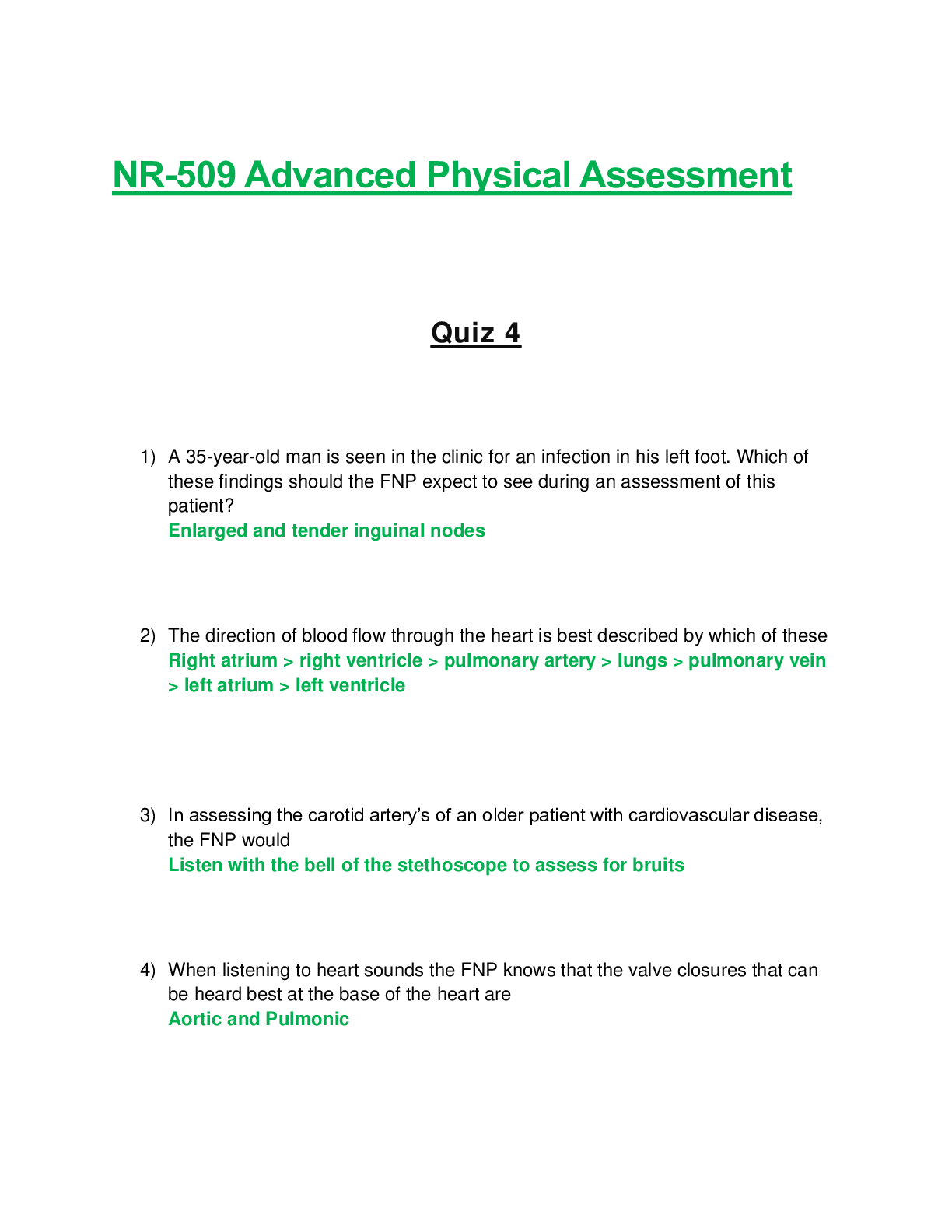

 (1).png)
